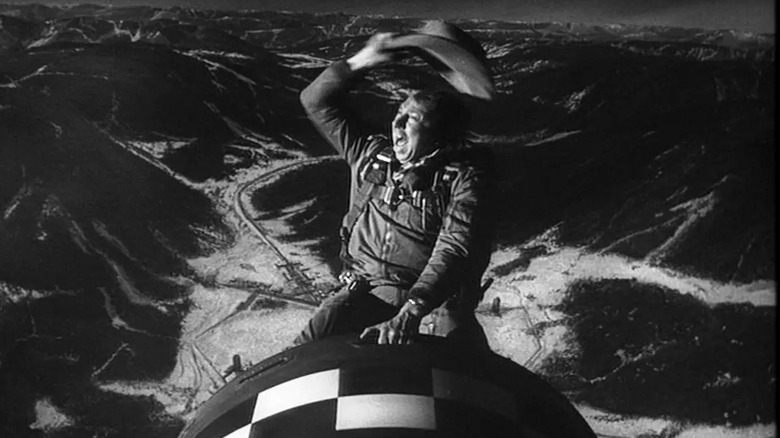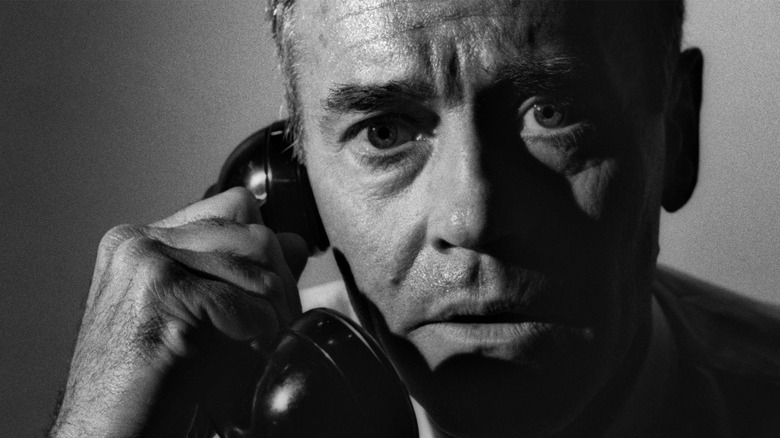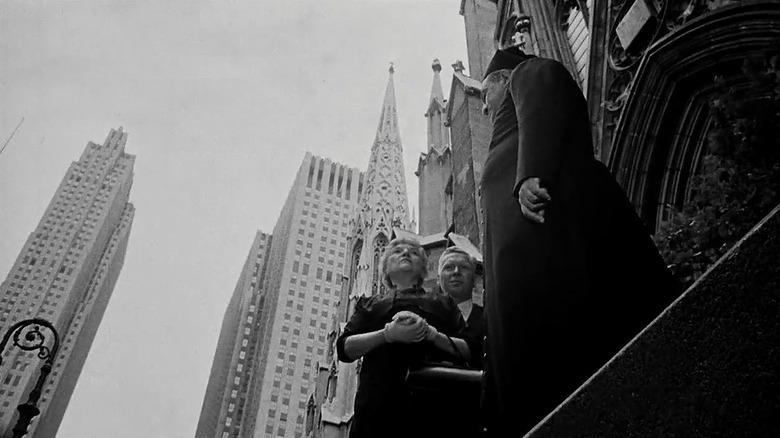A Stanley Kubrick Lawsuit Sunk Sidney Lumet's Dr. Strangelove Rival
Every year, it's almost inevitable that two movies with a similar premise will go head to head, whether it be a siege on the white house, an asteroid heading towards Earth, or a story about animated bugs fighting fascism. It's bound to keep on happening since it's been going on for so long — with 1964 as the year in which two competing movies told us how close we were to nuclear annihilation.
Stanley Kubrick's "Dr. Strangelove or: How I Learned to Stop Worrying and Love the Bomb" was released in January, while Sidney Lumet's "Fail Safe" came out in October. Each featured their own idiosyncrasies, but the one thing they did share was the looming nuclear threat bound to manifest itself. Kubrick's film took on a satirist tone with a paranoid Air Force commander sending out B-52 bombers to attack the Soviets, all while a group of disconcerted buffoons argue, taking guidance from a deranged (former) Nazi scientist.
Lumet's film, on the other hand, sees a similar scenario play out where the nuclear destruction of the USSR is imminent because of the US's incompetence. The key difference is that the attack is set into motion not by one individual, but the flawed system in place that gives the order out by accident. "Fail Safe" takes the matter very seriously as opposed to what Kubrick was doing.
The two films were not only competing at the box office in the same year and at the same studio with similar premises, but they would soon land themselves in a courtroom courtesy of the "Barry Lyndon" filmmaker.
Kubrick gave Fail Safe the Red Alert
Even with all of their differences, when Kubrick had gotten a whiff of "Fail Safe" going through at Columbia Pictures, he wanted to take the film to court, alleging plagiarism. According to a report from Slate, the case was settled with "Fail Safe" being pushed to the later half of the year so it wouldn't interfere with "Dr. Strangelove." It's obvious why Kubrick would be miffed with a thematically similar project clashing with his, but the argument of whether he was right or not to launch a lawsuit is complicated.
Kubrick had based "Dr. Strangelove" off of Peter George's 1958 novel "Red Alert." When word went around that "Fail Safe" was starting production, Kubrick and George saw its existence as a blatant rip-off of "Red Alert," with both taking the film to court on those grounds. Lumet's film, however, was more based on the 1962 novel of the same name.
Harvey Wheeler, one of the authors of "Fail Safe," had even claimed in an article for Life Magazine that he had started co-writing his novel with Eugene Burdick before "Red Alert" was ever released, but had difficulty in getting it published.
There's an irony in that Kubrick did all he could to shoot down "Fail Safe," only for his movie to ultimately be better received. The damage was done: "Fail Safe" had been pushed back to October where it died at the box office. Even the film's lead, Henry Fonda, who played the President, believed that he couldn't have played the role with a straight face if he saw "Dr. Strangelove" first.
Fail Safe does a better job of 'the point of no return'
"Fail Safe" posits a harrowing lose-lose scenario with its own set of consequences. Either the United States shoots down its own pilots and face an enormous case of mistrust in the public, or wait for them to drop the bombs on Moscow, which would instigate World War III. After a series of failed attempts to shoot down the bomber in association with the Soviets, Moscow is taken off the map. In order to prevent all-out war, the President orders a nuclear bomb to be dropped onto New York.
The nuclear threat of "Dr. Strangelove" sees its explosive finale as a nihilistic gag where we all go up because stupid people were in charge of our stupid arsenal. In "Fail Safe," however, the heavy decision to turn one of the country's most recognizable and populated cities into a nuclear crater is not taken lightly. You don't see the bombs drop, but rather the point of no return where the freeze frame snapshots show an average day in the life of New York for the last time in human history.
"Fail Safe" was shown to me in high school and after the credits rolled, you could hear a pin drop. Nobody really wanted to speak about what they just saw. I can still feel the pit in my stomach as the credits rolled atop the sound of New York's final moments. I was aware that what I just saw wasn't real, but "Fail Safe" still leaves you with the gut churning thought of the day where your world is decimated forever in the blink of an eye.
Both "Dr. Strangelove" and "Fail Safe" are currently available to rent on most VOD streaming platforms.


